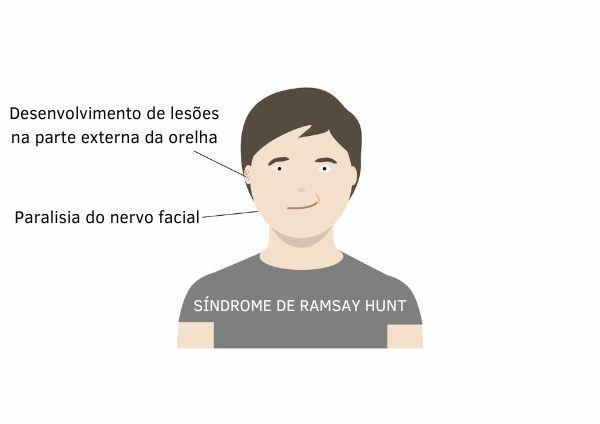THE sRamsay Hunt syndrome occurs due to a reactivation virus cause of latent chickenpox in the geniculate ganglion. This syndrome is characterized by the appearance of lesions in the auricular pavilion and a picture of peripheral facial paralysis.
Treatment is done with the use of antiviral drugs, which should be administered soon after the onset of symptoms to ensure a better recovery. Painkillers and eye lubricants are also recommended, in addition to physical therapy.
Know more: Haff syndrome — a health condition that is characterized by severe muscle pain
Ramsay Hunt Syndrome Summary
Ramsay Hunt syndrome occurs due to a reactivation of the virus that causes the chickenpox which was latent in the geniculate ganglion of the facial nerve.
After a person develops chickenpox, the varicella-zoster virus remains latent in the body, and a drop in immunity can cause it to reactivate.
Ramsay Hunt syndrome is characterized by the appearance of peripheral facial paralysis and lesions in the pinna.
The diagnosis of the syndrome is usually made through a detailed analysis of the symptoms presented by the patient. However, in some cases it may be necessary to perform virological and/or serological tests.
Treatment includes the use of antiviral medications.
What is Ramsay Hunt Syndrome?
Ramsay Hunt syndrome (RHS) is a health problem that occurs due to à varicella zoster virus reactivation, the virus that causes chickenpox, which is latent in the geniculate ganglion of the nerve facial. The syndrome was described in 1907 by James Ramsay Hunt.
Characterized by the association of the so-called herpes zoster oticus with an acute peripheral facial paralysis, SRH is known to cause 7 to 16% of non-traumatic unilateral peripheral facial palsies. It stands out for presenting a more severe evolution than the so-called Bell's facial palsy, a paralysis that has no detectable cause.
→ Varicella-zoster virus
The varicella-zoster virus is a linear genome virus of DNA double tape that stands out for its latency capability. During primary infection, the virus causes chickenpox, also known as chickenpox, a highly contagious disease that occurs most often in children. The characteristic clinical manifestation of the disease is skin lesions and itching.
After infection primary the virus remains in a latency stage in the nerve ganglia.This latency can be broken in situations where the individual experiences a drop in their immunity. In this case, the virus replicates itself again, and can manifest itself as shingles. THEsRamsay Hunt syndrome occurs when varicella-zoster reactivation occurs in the geniculate ganglion.
Symptoms of Ramsay Hunt Syndrome

Ramsay Hunt syndrome causes peripheral facial paralysis, generally unilateral, and the development of lesions in the auricle. Among both, the most common symptom of the syndrome is peripheral facial paralysis, which reaches maximum intensity during the first week after its onset.
Paralysis causes the person to have loss of movement in part of the face, not being able, for example, to smile or close the eyes. In addition to peripheral facial paralysis and the appearance of lesions, the patient may have others symptoms, as:
ear pain;
vertigo;
buzz;
hearing loss;
vomiting;
nausea;
involuntary and repetitive eye movements.
Also know: Guillain-Barré syndrome — the syndrome that affects the peripheral and cranial nerves
Diagnosis of Ramsay Hunt Syndrome
Ramsay Hunt syndrome has a basically clinical diagnosis, with the analysis of the symptoms presented by the patient. However, in some situations it may be necessary virological and/or serological tests for virus identification. It is worth emphasizing the need for an early diagnosis for greater success of treatment and prevention of complications of the disease.
treatment ofRamsay Hunt syndrome
Until the moment, there is not one consensus on the treatment of sRamsay Hunt syndrome. However, most professionals agree that antiviral drugs should be introduced within the first 72 hours of the onset of symptoms, in order to achieve a better recovery of the patient. Many professionals also prescribe corticosteroids, this measure being questioned. In addition, analgesics, eye lubricants and physical therapy are recommended for the treatment of the syndrome.
By Vanessa Sardinha dos Santos
Biology teacher
Source: Brazil School - https://brasilescola.uol.com.br/saude/sindrome-de-ramsay-hunt.htm



